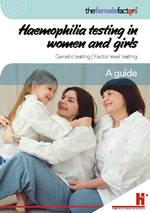Haemophilia testing in women and girls
Key points
- There are two types of haemophilia testing for women and girls
- Genetic testing shows if you have a gene change that is linked to haemophilia
- Factor level testing shows your blood clotting factor levels. If you have low levels, you may have bleeding symptoms/haemophilia.
- You may need to have both genetic testing and factor level testing.
Why test for haemophilia in women and girls?
- To investigate whether a woman or girl is affected by haemophilia
- If a woman or girl is affected by haemophilia, she will need a treatment plan
- Preparing for puberty and possible issues with periods
- Information for pregnancy or family planning
- Preparing a safe childbirth for mother and baby
- In case she needs surgery or dentistry in the future
- To help with diagnosing haemophilia in other family members.
Meera's story
 Meera’s brother has haemophilia, but Meera doesn’t have any bleeding problems. When her clotting factor levels were tested, they were normal. However, when she had genetic testing, she found out that she had a gene change for haemophilia. This was important to know because she might pass the gene change on to any children she has in the future.
Meera’s brother has haemophilia, but Meera doesn’t have any bleeding problems. When her clotting factor levels were tested, they were normal. However, when she had genetic testing, she found out that she had a gene change for haemophilia. This was important to know because she might pass the gene change on to any children she has in the future.
Sarah's story
 Sarah has had heavy periods ever since she was a teenager, bleeds for a long time whenever she has dental work and bruises easily. Her doctor sent her to a Haemophilia Treatment Centre where they tested her clotting factor levels and found that they were lower than normal. She had genetic testing which confirmed that she had a gene change for haemophilia. Sarah was diagnosed with mild haemophilia.
Sarah has had heavy periods ever since she was a teenager, bleeds for a long time whenever she has dental work and bruises easily. Her doctor sent her to a Haemophilia Treatment Centre where they tested her clotting factor levels and found that they were lower than normal. She had genetic testing which confirmed that she had a gene change for haemophilia. Sarah was diagnosed with mild haemophilia.
The gene change she has can be passed onto her children. Her particular gene change causes severe haemophilia in males.
Now Sarah’s specialist doctors have prepared an ongoing treatment plan for her so that she doesn’t have heavy periods and won’t have unnecessary bleeding when she visits the dentist or has surgery in the future. She has also had specialist genetic counselling on her options for planning and managing future pregnancies.
Haemophilia testing in women and girls: a guide
Download the PDF

